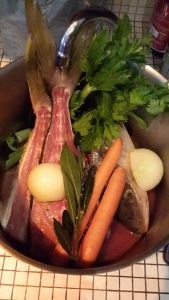
I first encountered viskopsop, that poor man’s staple during the leanest and meanest of times, in the Constantia home of a posh family fallen on hard times. That they were all barking mad might have had something to do with their penurious state, since one or more members of the family were forever being carted off in the wee hours to a sanatorium and once, to jail. I had a suspicion that the rent I paid them for those few months was probably their only income at the time, since there was always a flurry of activity in the kitchen at month’s end after my bank transaction had gone through. The household seemed to live largely on gin and drama, with scrambled eggs for supper occasionally. For the rest, I scarcely ever saw them eat.
Viskopsop, however, seemed to be a particular favourite. Indelibly imprinted in my mind is the memory of the pater familias, half-sozzled, cardigan flapping about as he scurried to and fro in the kitchen, occasionally stopping to smile glassily at no-one in particular while exclaiming ‘Aaaaaa…viskopsop!’
I never thought to ask for the recipe, which I regret, since I haven’t been able to track down a written version of a viskopsoprecipe yet. I once spent a morning in the company of a craggy-faced old fisherman in Kalk Bay harbour, who painstakingly told me how to make viskopsop. It seemed to involve little more than fish heads, onions and water. Oh, and a little potato, if you like. And maybe some tomato. Every version told to me of viskopsop inevitably ends with the addendum: ‘En dalk ‘n aartappeltjie ook…En bietjie tamatie.’
Since I had some lovely fresh fish carcases and the head of the 2.65kg yellowtail I’d bought for the pickled fish recipe on this blog, I decided to create my own version of viskopsop from scratch, and annotate the results for your delectation here on my blog. It turned out remarkably delicious and I was pleased when my son and his father wolfed down several bowlfuls each at suppertime. But then, they love fish. To me (not a great fish-eater at the best of times), the soup tasted a little too…well, fishy. Perhaps I should have heeded the advice of Angolan George at Willoughbys, who told me that yellowtail heads are not best suited for viskopsop, as ‘the stock will turn too dark’. Angolans know a thing or two about fish, for sure, but it wasn’t clear whether George meant ‘dark’ strong in taste or ‘dark’ in colour. Next time I visit George, I’ll ask him.
The Recipe
I started off making a simple fish stock using only the fish head and carcases, 1 large, peeled whole onion, 2 whole unpeeled carrots, some bay leaves (if you have it) and 2 sticks of celery. Cover in plenty of cold water in a very large pot, and bring to the boil. Turn the heat down so that the liquid bubbles gently, put the lid on and cook for 30 minutes. Now turn the heat off completely, leaving the pot on the stove, and let all the ingredients sink to the bottom. Let the whole business stand like that for 30 minutes. I read somewhere once that this trick ensures a clear stock (also, keeping the vegetables whole) and so waar as vet, it works, even when making chicken, beef and vegetable stocks.
After this resting period, you can once more bring your stock to the boil and let it bubble away for 2 or 3 hours. Not a fast and furious boil, just a nice little murmuring bubble. At the end of this period, you can pour your stock into a deep bowl through a strainer, and discard the solids, which will have had all the flavour cooked out of them by now. The liquid you have left in the bowl will be alive with the essence and flavour of the sea. You don’t want to mess with this precious extraction, so be careful what you do next. Also, remember that the true origin of viskopsop is of subsistence food when there’s hardly anything else available to eat or cook with.
I chopped 2 onions very finely and softened it slowly in hot oil – we call this smoor in Afrikaans, to braise slowly, usually with the lid on. Into the pot went 4 medium potatoes, also peeled and chopped into small pieces. Put the lid on and cook over gentle heat for 5-7 minutes, but don’t brown. Now pour in your precious viskopaftreksel and bring to the boil. Following tips from Facebook friends, I added a generous dessertspoon of Rajah All in One curry powder and a tin of tomato that I had blitzed to a puree first. No salt yet, that comes later. Generous shakes of finely ground white pepper.
Cook until aromatic, reduced to your liking, season to taste and serve piping hot.
That is all: it’s viskopsop.
However, I let intuition guide me (this was an experiment, after all) and added a generous splash of Thai fish sauce and the merest suggestion of trachang, or shrimp paste. To round out the taste, I also added a splash of brown vinegar, a spoonful of sugar, a handful of kaffir lime leaves, one crushed stalk of lemongrass and a few cardamom pods for the last 30 minutes of simmering. None of which was necessary, but certainly delicious. Serves 4-6.